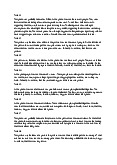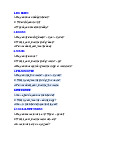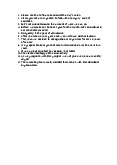



















Preview text:
TRƯỜNG ĐẠI HỌC DUY TÂN KHOA NGOẠI NGỮ
BỘ MÔN: ANH VĂN KHÔNG CHUYÊN
BIÊN SOẠN: Th.S DƯ THỊ TRANG ANH Th.S PHAN THỊ LỆ HUYỀN GIÁO TRÌNH SPEAKING – Level 2 ENG 169 LƯU HÀNH NỘI BỘ Đà Nẵng, năm 2018 TABLE OF CONTENT
PART I: READ A TEXT ALOUD..........................................................................3 Lesson 1: T ips for improvi ng reading a text aloud and practice ................... .... .. ... ... . 3
PART II: DESCRIBE A PICTURE........................................................................8
Lesson 2: Some tips to improve picture description..................................................8
Lesson 3: Vocabulary and common expressions in picture description.....................13
Lesson 4: Practice about picture description
PART III: RESPOND TO QUESTIONS...............................................................22
Lesson 5: Some suggested guides to respond to questions with “ Who, What. Which”
22 Lesson 6: Some suggested guides to respond to questions with
“ Where, When, Why & How......................................................................26 Lesson 7: Structuring your responses
................................. ............... ... .. .... .. ... ... .. .... . 30
Lesson 8: Practice structuring your responses...........................................................36
PART IV: RESPOND TO QUESTIONS USING INFORMATION PROVIDED
………………………………………………………………………………………….38
Lesson 9: Common words & Expressions in some text types...................................38 Lesson 10: Structuring your re sponses – T ip 1
........................................ ..... ... .. .... ... . 43
Lesson 11: Structuring your responses – Tip 2..........................................................48 Lesson 12: Practice
..........................................
...................................... .. .... .. .... ... .. ....51 Lesson 13: Model T est 1
........................................
.................................. .... .. ... ... .. ....56 Lesson 14: Model T est 2
........................................
.................................. .... .. ... ... .. ....73 2
LESSON 1: TIPS FOR IMPROVING READING A TEXT ALOUD AND PRACTICE Targeted Skills
In order to do well on Questions 1 and 2, you must be able to:
• pronounce common words correctly.
• use correct intonation when reading sentences.
• use correct stress on syllables and words. Things to Remember
1. Scan the entire text before reading so you have an idea of the content.
2. Read clearly and in a voice that can be easily heard.
3. Remember to pause for commas and periods.
4. Be sure to use intonation that matches the meaning of the sentences.
5. Be careful to pronounce the words correctly.
TIP 1 Practice correct pronunciation and learn to recognize “tricky” sounds.
TASK 1: Read each word and focus on its consonant sound
TASK 2: Look at the words. How many syllables do you think each word has?
Write the number for your guess for each word in the first column
TIP 2 Learn stress in order to pronounce words correctly
• In nouns and adjectives with two syllables, the stress usually falls on the first syllable.
For verbs with two syllables, the stress usually falls on the second syllable
• For nouns that end in -ion, -sion, -tion, or -ic, the stress will be on the syllable right
before the suffix: nation, conversion, graduation.
• For verbs with -ize or -ate suffixes, the stress will be on the first syllable of a three-
syllable word or the second syllable of a four-syllable word: specialize, anticipate.
• For words ending with -cy,-ty, -phy, -gy, or -at, the stress will be on the third syllable
from the end: democracy, photography, university, ge raphy og , principle.
TASK: Read the sentences and notice the boldfaced words. Circle the boldfaced
words that are nouns, and underline the boldfaced words that are verbs.
TIP 3 Use correct intonation for phrasing in statements.
• Statements typically have falling intonation, meaning the speaker’s voice lowers slightly at the end of the sentence.
• Information questions usually start with the word Who,What, Where, When, Why, or
How. These types of questions have falling intonation at the end of the sentence.
• Yes-No questions usually start with some form of an auxiliary verb, such as do, have,
can, or be. These types of questions, including tag questions at the ends of sentences, have an up intonation.
TASK : Mark the phrasing of each sentence with rising or falling intonation marks,
then read the whole sentence correctly
1. We will need ushers, ticket takers, and box office staff at the theater this weekend.
2. At this time, there is no one available to take your call. Please leave a message after the beep.
3. Our number is 202-555-4567. Please call if you have any problems.
4. Because the application forms were late, we’ll need to adjust the start date.
5. Please turn off all cell phones and pagers before the movie begins.
6. In conclusion, we’d like to thank all of our guests for their participation.
7. You will need to take warm clothing, an umbrella, hiking boots and a thermos flash.
8. There are a lot of processes associated with coffee production: picking, pulping,
hulling, peeling, milling and toasting.
9. Mountain climbing, a challenging sport, requires special training, and it empowers one
with courage, strength and optimism.
10. Ginger, which is grown in South America, Japan and tropical Asia, is a commonly
used spice in Australia. It has heart-shaped leaves and brownish purple flowers. PRACTICE
Read the texts and pay special attention to the highlighted words and
phrases. These are stressed words and phrases or especially tricky words. TEXT 1
Could we have your attention, please? We’d like to take this time to thank you
for attending this athletic banquet. This has been a fantastic year for our team
and our athletes. We now hold a new record for most wins in our states
division. Your support has allowed us to purchase new uniforms and a new
scoreboard for our field. To show our appreciation for the coaches, the staff, and
Of all the locations we‘ve seen so far, I strongly that y advise
ou select this sandwich shop and convert it to your n
LESSON 2: SOME TIPS TO IMPROVE YOUR PICTURE DESCRIPTION Targeted Skills
In Question 3, you should be able to:
• pronounce common words correctly.
• use correct stress on syllables and words.
• identify the important features of a photo.
• describe a photo using appropriate vocabulary.
• describe a photo using correct sentence structure Things to Remember
1. First, scan the photo. What information will you need in your response?
Brainstorm quickly when you see the image.
2. Next, think about what you want to talk about and how you want to say it.
You have 30 seconds to prepare and 45 seconds to respond.
3. You will hear a beep signaling when to start. Begin your answer with a sentence
starter, such as This is a picture of……..; In this photograph , there are . . . ; In this picture, I
see . . . .; The picture shows that……..
TIP 1 Be sure to use the correct noun or pronoun and the correct verb form. You can
organize your response by asking yourself: Who or what is the main subject in the photo?
Be sure to vary your response by using pronouns as well as different nouns to refer to the
people and things in the photo.
TIP 2 Use specific verb tenses and structures for basic descriptions. Make sure you are
comfortable with these tenses: simple present, simple past, and present and past
continuous. Also, make sure you can use There is/There are ....
TASK: Look at the picture and answer the questions
TIP 3 Use adjectives to give more information about people and objects. Adjectives
describe nouns, and more than one adjective can be used with a noun. Strings of
adjectives follow a specific order in English. In normal speech, English speakers rarely
use more than two or three adjectives to describe a noun. This chart will help you figure
out the correct order, even if you use only two adjectives together.
TIP 4 Use adverbs to give more information about verbs. Adverbs ending with -ly
can specify how something happens (quickly; slowly. Other adverbs are used to
describe how often something happens (sometimes, usually, frequently or the level of
certainty someone feels about something happening (probably, possibly, supposedly)
TASK : Circle the correct adverb in each sentence.
1. They are sitting ( quickly / quietly / sometimes) on a green blanket near the lake.
2. The man is ( probably / often / frequently) going to make a photocopy.
3. The customer is waiting ( usually / patiently / supposedly) to buy some fresh bread.
4. The man in the white shirt is from technology support. He’s working ( frequently /
quickly / usually) to fix the computer.
5. The baker has on a black cap that she ( probably / seldom / slowly) wears every day. PRACTICE
TASK 1. Match sentences a – f to the pictures 1–4 they are describing.
a. He appears to be writing a report.
b. They look like they are leaning against a car.
c. I think the woman is the girl’s mother.
d. He looks like a dentist or a doctor maybe.
e. It seems like they are having a good time.
f. She seems to be pointing at something.
TASK 2 . Match sentences a – e to the pictures 1–4
above Underline the probability words. a. He could be a scientist. b. It’s probably a birthday party
– they look like they’re playing a game .
c. They may be lost, so they’re looking at a map.
d. Perhaps they’ve made some homemade soup .
e. They might be playing a children's g ame .
Note: The adverbs ‘probably, perhaps, and maybe’ often come at the beginning of the sentence.
TASK 3: Match the sentence beginnings 1–6 to the correct ending a–f to describe picture 1 above 1. This man is … d , a. be lost. 2. They may have been … e, b. stopped for a break.
3. Perhaps they are driving … c c. across the U.S.A. for a vacation. 4. They might be trying … f d. probably the father. 5. Maybe they have … b e. driving a long way. 6. They could … a f. to find a motel. TASK 4: Complete sentences
1–5 using the words a–e below to indicate that the
information is an estimation or guess. More than one answer may be possible. 1. The man looks about
40 years old. Người đàn ông trông khoảng 40 tuổi 2. There are about
eight to ten kids in the picture. Có khoảng vài đứa trẻ từ 8 đến 10 tuổi trong bức tranh
3. Maybe it is some kind of stew. Có lẽ nó là một loại nước hầm
4. I think they are playing a game, or something . Tôi nghĩ họ đang chơi game hoặc cái gì đó 5. He looks a little
confused. Anh trông hơi bối rối a. around b. about c. a little d. some kind of e. or something
LESSON 3: VOCABULARY AND COMMON EXPRESSIONS IN PART II - PICTURE DESCRIPTION A. DESCRIPTION OF A PLACE
Some structures can be used as examples:
- There are many boats at the pier. -
( The pier is crowded with many boats) -
( The pier is full with many boats)
Some expressions are normally used: Feature, location Situation -
be displayed ( được hiển thị
- be busy with bận rộn với -
be arranged được sắp xếp - be sorted được sắp xếp
- be crowded with đông đúc với -
be set ( đc sắp xếp, cài đặt
- be packed with đc đóng gói - be put đc đặt - be left đc để lại - be full of đầy bởi - be tied bị ràng buộc - be placed đc đặt tại
- be filled with được lấp đầy với.. - be located đc định vị - be parked đc đậu - be scattered phân tán store B. DESCRIPTION OF PEOPLE’ S
APPEARANCE The verb ‘be’ can be used for most descriptions. Ex: He is handsome. She is nervous. They are frustrated. The buses are late. ◆ Some structures can be used: 1. S + be + adj
EX: He’s good-looking and scular 2. S + have/has + adj + Noun EX: She has long-black hair 3. Compound Adjs = Adj + N_ed
EX: - Jennifer is bronze-haired - She is a blue-eyed girl
Hair ( Structure: S + have/has + adj + Noun) - blond hair straight hair curly hair - wavy hair pigtails ( tóc đuôi sam)
a ponytail ( tóc kẹp đuôi ngựa)
Hair ( Structure: S + be + adj) - Bald (hói) brunet (tóc nâu) blond/ blonde (tóc vàng) Figure - Tall (cao) short (thấp) slim(mảnh mai) chubby (mập mạp) Clothing -
Jeans (quần bò) pants (quần dài) shorts (quần ngắn) turtleneck (áo cổ lọ) - shirt (áo thun) Skirt váy
cardigan ( áo len dài tay có nút cài) - coat (áo khoác) Sportswear
sweater ( áo len dài tay trống cổ) 2
-swimsuit đồ bơi Uniform đồngphục short/ long sleeved shirt - dress trang Blouse
sleeveless dress ( áo đầm không phục tay) - jacket áo Pajamas
track suit ( quần áo vận động viên) khoác đồ ngủ - Suit
lab coat ( áo khoác mặc trong phòng thí nghiệm) - vest ( áo ghi lê) Jewelry - ring Nhẫn Cap mũ Earringshoa tai hat Bracelet vòng tay - helmet Necklace watch Belt thắt Tie chun chuỗi hatk lưng buộc tóc - gloves Scarf khăn Sandals dép xăng Boots bốt Sunglasses đan Kính râm
C. DESCRIPTION OF PEOPLE’S FEELINGS Words to describe feelings Positive Negative Proud tự hào Angry Fun vui vẻ Frustrated bực bội Cheerful vui lòng Bad Relieved an tâm Nervous sợ Relaxed thư giãn Worried/ stressed Happy hạnh phúc Unhappy Pleased hài lòng Upset khó chịu In a good mood tâm Impatient không kiên trang tốt nhẫn Excited thích thú Disappointed thất vọng Optimistic lạc quan Pessimistic bi quan Comfortable thoải Bored mái 3 Eager Embarrassed Confident Unconfident … … 4 Structures can be used: 1. S + be + adj
EX: The girl is worried about her final test. 2. S + feel/ seem/look + adj
EX: - They seem excited at the football match.
- He feels disappointed with his scores.
- The woman looks happy with her children. PRACTICE
TASK 1: Make at least 2 statements to describe the following pictures 1.




